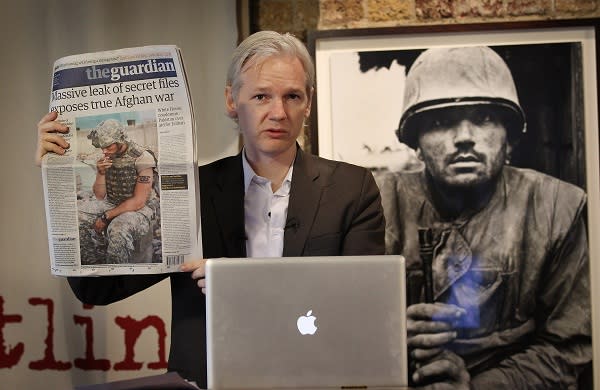 The Upshot
The UpshotWikiLeaks uses old, new media to publish documents

Call it Pentagon Papers 2.0. WikiLeaks’ publication of more than 75,000 military documents is already drawing comparisons with Daniel Ellsberg’s famously leaked cache of government documents that provided a gloomy perspective of the Vietnam War.
But this latest document dump to shake up Washington came together via a collaboration of old-school investigative reporting and new media tools that wouldn't have been available in the early 1970s.
WikiLeaks — an organization that publishes secret documents online to highlight the “unethical behavior” of governments and corporations — permitted the New York Times, the Guardian and Der Spiegel to view the documents weeks ago. As part of the review process, the three news organizations agreed to a publication embargo, which forbade them going public with their reporting on the documents prior to Sunday night, when WikiLeaks also posted them online.
WikiLeaks founder Julian Assange said in a London press conference Monday that he chose those three publications because they are “the best newspapers in the world for investigative research.”
Assange said that his organization has made a point of collaborating with news outlets — to a greater degree than it did during its other well-publicized leaks. He noted that Monday's Guardian devoted 14 pages to the story.
[Five biggest surprises in the WikiLeaks documents]
He said the press conference was being held in London because WikiLeaks has supporters in the city, and the London-based Guardian is a partner. Also, Assange said, "we had Der Spiegel and New York Times and us in a collaborative basement [in London], if you like, working on this material."
Bill Keller, executive editor of the New York Times, acknowledges that a Times reporter went to London to see the materials but pushes back against the notion that the publications and WikiLeaks all reported the story together.
Keller told The Upshot that the Times sent reporter Eric Schmitt to London to look at the documents because they were initially only available to review there in person. Schmitt spent a few days with the material in London to “appraise its scope and quality.” Next, Keller said, WikiLeaks “made the material available on a protected website.”
“All of our sorting, searching, assessing, analyzing and writing were done in New York, in a room on the fifth floor,” Keller said. “The Guardian and Der Spiegel worked, likewise, in their own newsrooms. Each of the publications prepared its stories independently.”
Only the most dedicated students of the Afghanistan conflict can be expected to have the wherewithal to sift through thousands of online documents. However, newspapers can contextualize the information and synthesize it in a way that's digestible to the average reader — and policy maker.
"The task of good journalism is to turn this material — who, when, where, how, how many — into something which emotionally engages people," Assange said.
In the press conference, Assange also sounded like an old newsroom hand when he described the rollout. He said that Monday's always good for releasing a big story because it can then "set the agenda for the week."
The WikiLeaks press strategy also makes sense considering Assange’s remarks to the New Yorker and IDG News Service. He told those outlets that he found it exasperating that WikiLeaks may publish thousands of secret documents online, and yet journalists don't always dig into the trove of previously secret information.
“It’s counterintuitive,” Assange said last October. “You’d think the bigger and more important the document is, the more likely it will be reported on, but that’s absolutely not true. It’s about supply and demand. Zero supply equals high demand, it has value. As soon as we release the material, the supply goes to infinity, so the perceived value goes to zero.”
So Assange kept the demand high in this instance by only offering the information to three major news outlets. Once those outlets accepted, they had a clear competitive advantage when WikiLeaks dumped the documents. And by having a few weeks' notice, the three publications could also report out and verify information to meet their own editorial standards.
[Photos: The faces behind the WikiLeaks scandal]
Media watchers quickly noted how WikiLeaks — working in conjunction with major news outlets — is changing the media landscape.
"In media history up to now, the press is free to report on what the powerful wish to keep secret because the laws of a given nation protect it," wrote NYU professor Jay Rosen. "But WikiLeaks is able to report on what the powerful wish to keep secret because the logic of the Internet permits it. This is new."
Rosen also called attention to the combination of traditional news outlets and WikiLeaks, which he describes as “the world’s first stateless news organization.”
“The information is released in two forms: vetted and narrated to gain old media cred, and released online in full text, Internet-style, which corrects for any timidity or blind spot the editors at Der Spiegel, the Times or the Guardian may show,” he wrote.
The Atlantic’s Alexis Madrigal wrote Monday that in addition to the impact on the Afghanistan War, the publication of these leaked documents “will be seen as a milestone in the new news ecosystem.”
He described a “new asymmetrical journalism,” where it isn’t “clear who is on what side or what the rules of engagement actually are.”
“But the reason WikiLeaks may have just changed the media is that we found out that it doesn't really matter,” he continued. “Their data is good, and that's what counts.”
Other popular Yahoo! stories:
• Obama to voters: 'Things could be worse'
• Immigrants flee Arizona ahead of strict new law
• Photo: Palatial mansion crumbles, awaits fate


